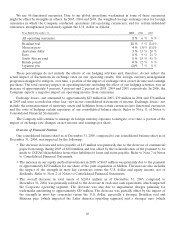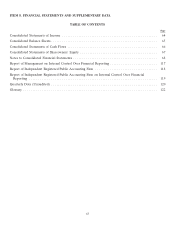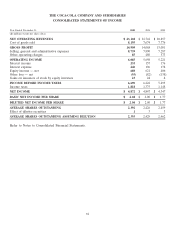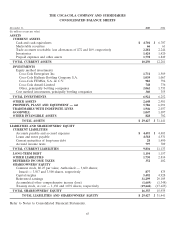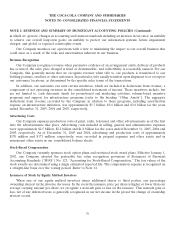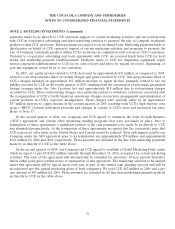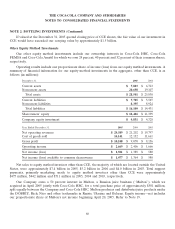Coca Cola 2005 Annual Report Download - page 72
Download and view the complete annual report
Please find page 72 of the 2005 Coca Cola annual report below. You can navigate through the pages in the report by either clicking on the pages listed below, or by using the keyword search tool below to find specific information within the annual report.THE COCA-COLA COMPANY AND SUBSIDIARIES
NOTES TO CONSOLIDATED FINANCIAL STATEMENTS
NOTE 1: BUSINESS AND SUMMARY OF SIGNIFICANT ACCOUNTING POLICIES (Continued)
in which we operate; changes in accounting and taxation standards including an increase in tax rates; an inability
to achieve our overall long-term goals; an inability to protect our information systems; future impairment
charges; and global or regional catastrophic events.
Our Company monitors our operations with a view to minimizing the impact to our overall business that
could arise as a result of the risks and uncertainties inherent in our business.
Revenue Recognition
Our Company recognizes revenue when persuasive evidence of an arrangement exists, delivery of products
has occurred, the sales price charged is fixed or determinable, and collectibility is reasonably assured. For our
Company, this generally means that we recognize revenue when title to our products is transferred to our
bottling partners, resellers or other customers. In particular, title usually transfers upon shipment to or receipt at
our customers’ locations, as determined by the specific sales terms of the transactions.
In addition, our customers can earn certain incentives, which are included in deductions from revenue, a
component of net operating revenues in the consolidated statements of income. These incentives include, but
are not limited to, cash discounts, funds for promotional and marketing activities, volume-based incentive
programs and support for infrastructure programs (refer to the heading ‘‘Other Assets’’). The aggregate
deductions from revenue recorded by the Company in relation to these programs, including amortization
expense on infrastructure initiatives, was approximately $3.7 billion, $3.6 billion and $3.6 billion for the years
ended December 31, 2005, 2004 and 2003, respectively.
Advertising Costs
Our Company expenses production costs of print, radio, television and other advertisements as of the first
date the advertisements take place. Advertising costs included in selling, general and administrative expenses
were approximately $2.5 billion, $2.2 billion and $1.8 billion for the years ended December 31, 2005, 2004 and
2003, respectively. As of December 31, 2005 and 2004, advertising and production costs of approximately
$170 million and $171 million, respectively, were recorded in prepaid expenses and other assets and in
noncurrent other assets in our consolidated balance sheets.
Stock-Based Compensation
Our Company currently sponsors stock option plans and restricted stock award plans. Effective January 1,
2002, our Company adopted the preferable fair value recognition provisions of Statement of Financial
Accounting Standards (‘‘SFAS’’) No. 123, ‘‘Accounting for Stock-Based Compensation.’’ The fair values of the
stock awards are determined using a single estimated expected life. The compensation expense is recognized on
a straight-line basis over the vesting period. Refer to Note 14.
Issuances of Stock by Equity Method Investees
When one of our equity method investees issues additional shares to third parties, our percentage
ownership interest in the investee decreases. In the event the issuance price per share is higher or lower than our
average carrying amount per share, we recognize a noncash gain or loss on the issuance. This noncash gain or
loss, net of any deferred taxes, is generally recognized in our net income in the period the change of ownership
interest occurs.
70


